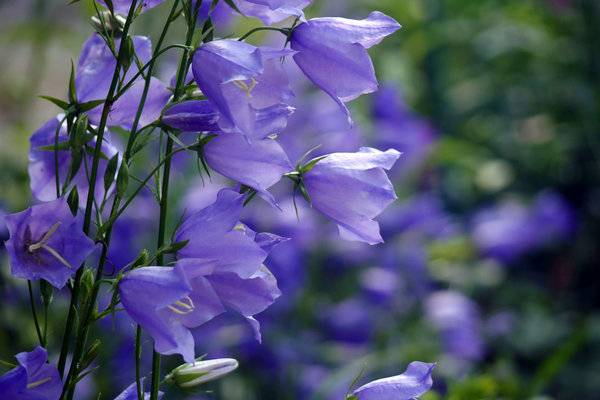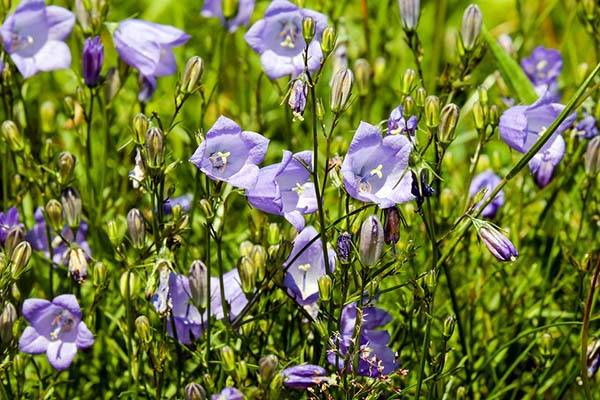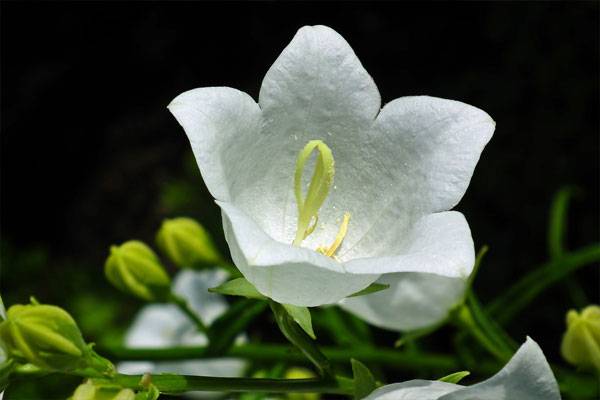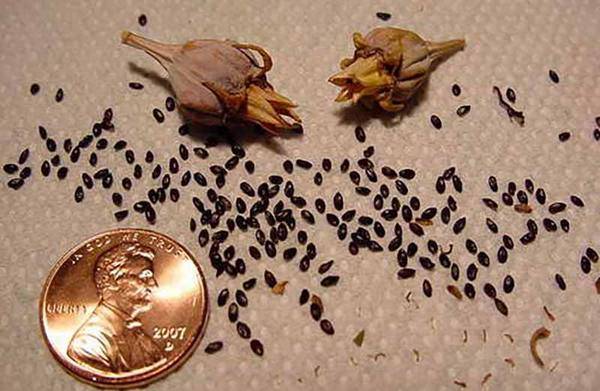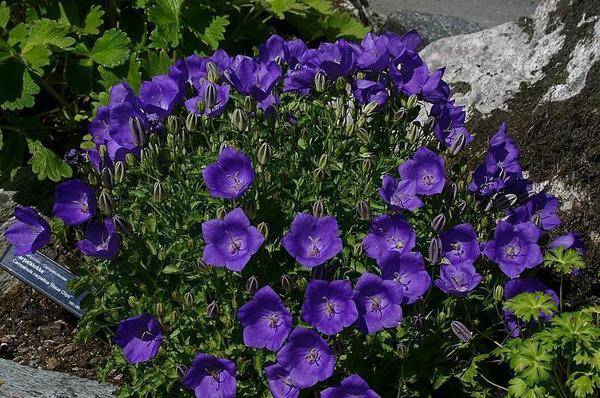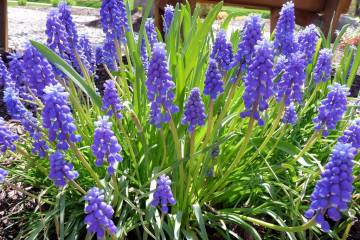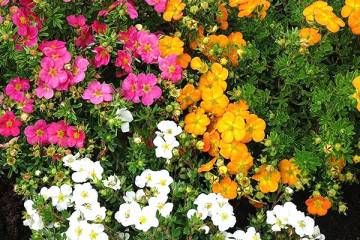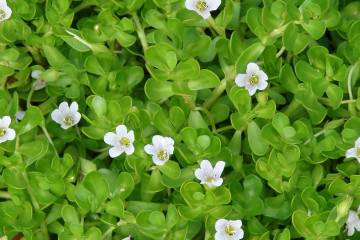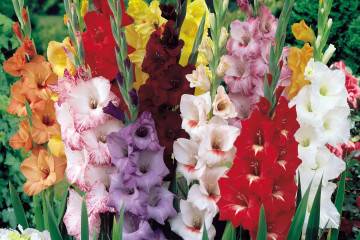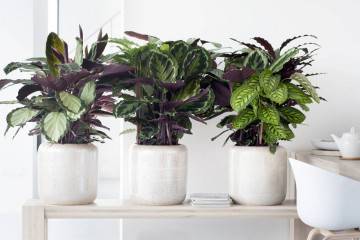Bells flowers - description of the plant and species
Content:
Bells are flowers that many gardeners like. In nature, they grow in steppes, meadows and rocky terrain. Unpretentiousness allowed them to win a worthy place among the cultivated plants grown in personal plots. The people like to call them chenille, bell or chebotk.
general description
The bell flower is a member of the Bellflower family, which has almost 300 subspecies.
Origin and appearance of bells
In nature, culture can be found in temperate climates - in Asian, Siberian, Caucasian, European territories and in North America. Perennial types are common, with occasional annuals and biennials. The buds outwardly resemble miniature bells, the stems are covered with narrow foliage.
Flowers are located on each shoot, with white, blue, blue or purple color. The inflorescences have a paniculate or racemose shape. After the end of the flowering period, small seed bolls are formed.
What does a bell look like?
The botanical description indicates what a bell looks like and what color of petals it has:
- The foliage on the shoots is arranged in alternating order.
- The inflorescences have a bell shape.
- The color of the petals depends on the type of plant; there are subspecies of snow-white, bluish, yellowish, purple, bluish, pinkish tones.
- In most species, the flowers are collected in a brush, in some cases there may be one bud of an outstanding size on the shoot.
Field bell - description
The field bell is referred to the herbaceous subspecies, with a funnel-shaped inflorescence (sometimes you can find paniculate and racemose variations). The shoots of the plant are simple, creeping or creeping type, exist with branches. The foliage is elongated.
Forest bell
Forest bells are often bluish. Less common are options with pinkish, snow-white or lilac petals. In nature, they can be found in temperate climates, cultivation in a personal plot requires the creation of the most suitable conditions for normal growth and development.
Popularly, it can be called musical - because of the legend about the sounds that it publishes on the night of Ivan Kupala.
Types and varieties of perennial garden bells
The garden bell is characterized by a large number of subspecies, differing in the size of the shoots, the color of the petals, and the volume of the buds.
Bell white
White bells live in Western European and Eastern European territories. The features of the species include:
- annual, biennial and perennial representatives;
- the duration of budding is almost a month and a half;
- shoots of spiral-leaved type;
- small or large buds, the original size depends on the varietal species.
Bell blue
Bluebells are members of a class of perennial plants that prefer to grow in forests, meadows or highlands. Among them, the following common subspecies are distinguished:
- Spoon-leaved - with a growth of 10 cm, creeping shoots and small, rounded foliage. The petals are painted in a pale blue shade.
- Pyramidal is a perennial plant, up to 1.5 m in height. The foliage is jagged type, the flowering duration is equal to the first two summer months. The scent of a flower for a person is similar to the scent of myrrh.
- Bearded - grows up to 25 cm, prefers meadows and mountainous regions. Inflorescences of a pale blue tone, with a paniculate or racemose shape. Budding takes place in the first part of the summer season.
- Perforated is a long-lived culture with heart-like leaves. The powerful inflorescences have a star-shaped shape, the size around the circumference is up to 3 cm. The buds appear in the first decade of June and fall off after September 10.
Blue bell
Meadow or steppe blue bells are identified by smaller inflorescences. A perennial garden bell, which is used more often than other relatives to decorate flower beds, is considered to be unpretentious and ornamental plants. Among the common options, the most famous are:
- Gargan - creeping shoots are formed into compact bushes, live quietly in darkened areas. The average height does not exceed 15 cm, the buds are large, open-looking, up to 4 cm in diameter. Flowers adorn the garden plot throughout July.
- Sarmatian - refers to bush Caucasian perennials, with a height of up to 45 cm. The buds are famous for their honey smell, the plant does not impose special requirements for supervision. Blooms from June to September.
- Ciliate - does not grow more than 15 cm, is characterized by high resistance to drought. Blooms in June, withers in July.
- Alpine - a subspecies with a height of 10 cm. The inflorescences have the shape of cylinders, when planting they require good drainage. It is used as a single plant or as a frame for tall shrubs.
Yellow bells flowers
Unusual yellowish petals are found in only two variations:
- Tirsoid wild - prefers the territory of dry alpine meadows, Pyrenean mountain slopes.
- Carniolica is a garden crop rarely used in the landscape, requires alkaline soil, the diameter of yellow inflorescences is up to 3 cm.
Bell pink
The culture is characterized by pinkish or light red petals, belongs to the common subspecies. Among them, the following frost-resistant options are distinguished:
- Albu-Nana - compact bushes are decorated with milky pink buds, there are pale stripes on the petals. Small flowers, oval-type foliage.
- Garland - grows up to 40 cm, with paniculate, large inflorescences. On pinkish buds, dots of a purple hue may be highlighted. Blooms with the arrival of summer.
- Pearl Sensation - grows up to 1.5 m, decorates the garden with its pinkish buds in July-August.
Bell purple
There are natural and cultivated varieties with purple petals:
- Brittle - refers to ampelous crops, buds are formed in the spring months. The foliage is small.
- Perskikolisty - a herb with leaves of a dark green tone. It differs in the apical inflorescence and short pedicels, the petals are painted in lilac or purple tones. Flowers form by mid-July.
- Campanula is uniform - grows up to 0.3 m, branches are thin and hanging. Identified by numerous small buds and transparent purple petals.
- Broad-leaved - characterized by voluminous and wide foliage, growing up to 130 cm.The buds are large, collected in racemose inflorescences.
- Milk-flowered - the brainchild of French breeders is known for its oblong foliage and branchy shoots. In racemose inflorescences, buds with a diameter of up to 40 mm are collected.
- Interesting subspecies include Portenschlagu - due to the simplicity of cultivation. Its budding lasts from May to August.
Planting a bell in open ground
Do-it-yourself planting work is carried out according to the standard algorithm. Subject to all requirements, the culture will delight with its bright buds throughout the summer season.
Growing bells from seeds
Before planting, preliminary preparation of seed material is carried out; ordinary paper and a saucer are used for it. The seeds are sprinkled on a moistened leaf, which is carefully transferred to a plate filled with water. After the appearance of the first shoots, the young are transplanted into the prepared soil.
The soil should be loose and light, with good drainage. It is moistened, and the seeds are pressed a little. After re-spraying, the boxes are covered with plastic wrap and moved to a warm room.
After 14 days, seedlings will appear, after which it is required to remove the covering material. The seedlings are allowed to grow and grow stronger, the soil is regularly loosened and watered. With excessive planting density, a dive is carried out - when the first two leaves are formed.
What you need to plant bells
The plant is distinguished by its love for diffused lighting and a stable temperature regime, not lower than 15 degrees. The soil is constantly loosened and irrigated, the green part is sprayed. You need to take care of young individuals carefully so as not to accidentally injure the thinnest branches.
The transplant is carried out in the spring - the plants are removed from the pots along with the earthen lump and transferred to the previously prepared holes. The voids are covered with a substrate, compacted and watered.
How to choose the best place
When landing in fresh air, choose a place located away from tall and branched shrubs and spreading trees that can block the sun. The plant prefers to grow on calcareous and slightly alkaline soils, with good drainage.
The distance between shrubs depends on their final size:
- for tall people - not less than 0.5 m;
- for medium-sized people - 0.3 m;
- for miniature ones - 10 cm.
How to feed bells for lush bloom
When planting, do not forget about turf and fertilizers. Peat, manure and bird droppings are prohibited - they are sources of fungal infections. Preventive treatment against diseases and insect pests is carried out using granular superphosphate.
To obtain the most lush flowering, fertilizers are introduced into the soil:
- primary feeding is prescribed for the spring - a composition containing nitrogen is bought for it;
- secondary - after the formation of the first buds, during this period it is better to use complex mixtures.
Preparing for winter
For one-year and two-year options, preparatory work is not carried out. Long-lived crops require pruning to low points after September 20. Frost-resistant species will calmly survive the winter, and for thermophilic species, a shelter consisting of dry foliage and spruce or pine paws is needed. Tall individuals are additionally covered with a layer of humus and peat - 30 cm.
Bells are unpretentious plants that can be used to create a bright and memorable landscape design. They will be able to add color to front gardens, flower beds and alpine slides. Artists like to use them as a stencil for coloring - therefore, it will not be difficult for a child to draw and name such a flower.
